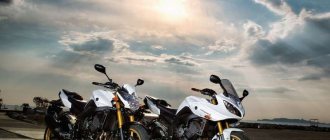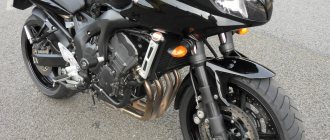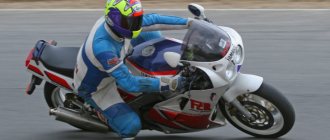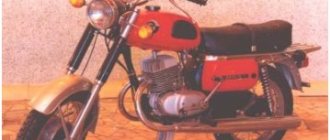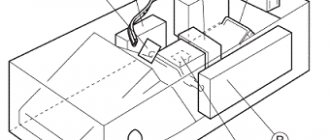Brief history of the model
- 2004 - The official start of production and sales of the Yamaha FZ6N and Yamaha FZ6S, which replaced the Yamaha FZS 600 model.
- 2006 - The model receives updates to the engine and fuel injection system to obtain better low-end torque and a smoother power take-off. Additionally, the bike gets a new frame, swingarm and wheels in black.
- 2007 - The European version of the Yamaha FZ6 was "strangled" to 78 hp, however, a full-power (98 hp) version of the Yamaha FZ6 S2 was also available, which had a slightly different seat, passenger pegs, brake calipers and dashboard from Yamaha FZ1.
- 2008 – The European version of the Yamaha FZ6 S2 now comes with ABS and an immobilizer as standard on the motorcycle.
- 2009 - only versions of the Yamaha FZ6 S2 are sold on the European market.
- 2010 - in the US market, the Yamaha FZ6 series is completely replaced by the Yamaha FZ6R (with a full fairing); in Europe, the Yamaha FZ6 Fazer S2 (with a semi-fairing) and the Yamaha FZ6 S2 (naked version) continue to be sold. The derated (78 hp) versions of the motorcycle were replaced by the Yamaha XJ6 Diversion model series. In the same year, the FZ6 was replaced by the updated Yamaha FZ8 model.
Brief history of the model
Model:
Yamaha FZ1 (FZS1000N/NC) USA.
Model:
Yamaha FZS1000 Fazer (Europe).
Model code:
5LV1, 5LV2, 5LV3, 5LV6.
Model:
Yamaha FZ1 (FZS1000P/PC) USA.
Model:
Yamaha FZS1000 Fazer (Europe).
Model code:
5LV8, 5LV9, 5LVA, 5LVD.
Model:
Yamaha FZ1 (FZS1000R/RC/SPR) USA.
Model:
Yamaha FZS1000 Fazer (Europe, South Africa).
Model code:
5LVF, 5LVH, 5LVN, 5LVP, 5LVR, 5LVG, 5LVM, 5LVU.
Model:
Yamaha FZ1 (FZS1S/SC) USA.
Model:
Yamaha FZS1000 Fazer / FZS10S (Europe, South Africa).
Model code:
1C21, 1C23, 1C27, 1C25, 1C26, 1C22, 5LVY.
Model:
Yamaha FZ1 (FZS1T/TC, FZ1T/TC) USA.
Model:
Yamaha FZS1000 Fazer / FZS1000S/T (Europe).
Model code:
1C2B, 1C29, 1C2A, 1C28, 1C2F.
Model:
Yamaha FZ1 (FZS10V/VC) USA.
Model:
Yamaha FZ1-N / FZ1-S Fazer (Europe, Australia).
Model code:
3C38, 3C37, 3C39, 3C32, 3C33, 3C31, 2D12, 2D13, 2D11, 3C36.
Model:
Yamaha FZ1 (FZS10W/WC) USA.
Model:
Yamaha FZ1-N / FZ1-S/SW Fazer (Europe, Australia).
Model code:
3C3C, 3C3B, 3C3A, 2D19, 2D18, 2D17, 2D16, 2D15, 2D14, 5D01, 5D02, 3C3F.
Model:
Yamaha FZ1 (FZS10XCR/XCGY) USA.
Model:
Yamaha FZ1-N / FZ1-S/SX Fazer (Europe, Australia, Japan).
Model code:
3C3K, 2D1G, 2D1D (Australia);
3C3J, 3C3H, 2D1F, 2D1E, 2D1C, 2D1B, 22C4, 22C3, 22C2, 22C1, 5D04, 5D03, 3C3N (Europe); 3C3G, 2D1A (Japan).
Model:
Yamaha FZ1 (FZS10YL/YCL, FZS10YG/YCG) USA.
Model:
Yamaha FZ1-N / FZ1-S/SY Fazer (Europe, Australia, Japan).
Model code:
3C3S, 2D1P, 2D1L (Australia); 3C3R, 3C3P, 2D1N, 2D1M, 2D1K, 2D1J, 22C8, 22C7, 22C6, 22C5, 5D05, 5D06, 3C3V (Europe); 3C3W (Japan).
Model:
Yamaha FZ1 (FZS10ZR/ZCR, FZS10ZB/ZCB) USA.
Model:
Yamaha FZ1-N/NA, FZ1-S/SA Fazer (Europe, Japan).
Model code:
1CA4, 5D09, 5D07, 3C3X, 1CA5, 22CB, 22C9, 1D1U, 2D1R (Europe); 1CA8, 2D1X (Japan).
Model:
Yamaha FZ1 (FZS10AS/ACS) USA.
Model:
Yamaha FZ1-N/NA, FZ1-S/SA Fazer (Europe, Japan).
Model code:
1CAE, 5D0D, 5D0B, 1CAF, 1CA9, 22CD, 1EC1 (Europe); 1CAJ (Japan).
Model:
Yamaha FZ1 (FZS10BW/BCW) USA.
Model:
Yamaha FZ1-N/NA, FZ1-S/SA Fazer (Europe, Japan).
Model code:
1CAS, 5D0F, 1CAK, 22CF, 1EC4 (Europe); 1CAU, 1CAT, 1EC8, 1EC7 (Japan).
Model:
Yamaha FZ1 (FZS10D/DC) USA.
Model:
Yamaha FZ1-S Fazer (Europe, Japan).
Model code:
1CAY (Europe); 2DV2 (Japan).
Model:
Yamaha FZ1 (FZS10EW/ECW, FZS10E/EC) USA.
Model:
Yamaha FZ1 (FZS10FGY/FCGY) USA.
Frame numbers of different generations of the Yamaha FZ-1 model:
| Year of issue | Frame number |
| 2001-2002 | RN06x |
| 2003-2004 | RN07x |
| 2005 | RN14x |
| 2006 | RN16x, FZ1 Fazer – RN17x |
| 2007 | RN17x |
| 2008- | RN21x |
Brief history of the model
Model:
Yamaha FZ6 (Naked), Yamaha FZ6 Fazer (all regions).
Model code:
5VX3, 5VX4 (North America), 1B31, 5VX1, 5VX5 (Europe), 5VX2 (Oceania).
Model:
Yamaha FZ6 (Naked) / FZ6-N, Yamaha FZ6 Fazer / FZ6-S (all regions).
Model code:
5VX8, 5VX9 (North America), 1B33, 1B35, 5VX6 (Europe), 1B34, 1B36, 5VX7 (Oceania).
Model:
Yamaha FZ6 (Naked) / FZ6-N + ABS, Yamaha FZ6 Fazer / FZ6-S + ABS, Yamaha FZ6-S2 / S2 Fazer (all regions).
Model code:
5VXH, 5VXJ (North America), 1B3B, 1B37, 1B39, 5VXB, 5VXD, 4P51, 4P52, 5VXK (Europe), 1B3A, 1B3C, 1B38, 5VXC, 5VXG (Oceania).
Model:
Yamaha FZ6 (Naked) / FZ6-N + ABS, Yamaha FZ6 Fazer / FZ6-S + ABS, Yamaha FZ6-S2 / S2 Fazer + ABS (all regions).
Model code:
4S82, 4S83 (North America), 1B3D, 5VXL, 5S51, 5S41, 5S31, 5S21, 4S81 4S84,, 4P54, 4P53 (Europe), 5S52 (Oceania).
Model:
Yamaha FZ6 (Naked) / FZ6-N + ABS, Yamaha FZ6 Fazer / FZ6-S + ABS, Yamaha FZ6-S2 / S2 Fazer + ABS (all regions).
Model code:
4S88, 4S89 (North America), 5S53, 5S42, 5S22, 4S86, 4S8A (Europe), 5S54, 4S87 (Oceania).
Model:
Yamaha FZ6 (Naked) / FZ6-N + ABS, Yamaha FZ6 Fazer / FZ6-S + ABS, Yamaha FZ6-S2 / S2 Fazer + ABS, Yamaha FZ6-R (all regions).
Model code:
5S56, 4S8C (Oceania), 5S55, 5S44, 5S43, 5S57, 5S23, 4S8B, 36P6, 36P3, 4S8F (Europe).
Model:
Yamaha FZ6R (North America).
Model code:
FZ6RZW, FZ6RZL, FZ6RZR, FZ6RZCW, FZ6RZCR, FZ6RZCL, FZ6RZCB, FZ6RZB.
Video
- Review and test drive of the Yamaha FZ1-N motorcycle.
- Review of the first generation of the Yamaha FZ1 Fazer (FZS1000) motorcycle.
Yamaha FZ-1
— the flagship model of the “Phaser” line, which traditionally includes motorcycles produced in several versions. Designed using the experience of producing the legendary YZF-R1 sportbike, the FZ-1 is, without exaggeration, a magnificent bike. In 2021, Yamaha presented a new model of the MT series - the MT-10, which is destined to become its new flagship, displacing the Yamaha MT-09, but it is not yet entirely clear how the appearance of a new “liter” will affect the fate of the FZ-1. Considering the enormous popularity of this model, there is every chance that it will remain on the assembly line for a long time.
Externally, the older “Phaser” is very similar to its younger brothers - Yamaha FZ-6 and Yamaha FZ-8, and, like them, FZ-1 has two versions - FZ-1N, that is, a naked bike, and FZ-1S , that is, the version with a plastic fairing, also found under the name FZS 1000 (first generation only). The history of the model goes back two generations - the first was produced from 2001 to 2005, and the second was produced from 2006 to the present. The difference between generations is quite significant - more recent motorcycles received a diagonal aluminum frame instead of steel, an injector instead of carburetors, stronger brakes, improved suspension and a modified engine.
Speaking of the engine, it is perhaps one of the main advantages of the Yamaha FZ-1. This inline-four was borrowed from the YZF-R1, derated and retuned, ultimately producing 150 hp. (146 on the first generation FZ-1) and 106 Nm of torque. The engine of the flagship Phaser works best at medium speeds, reaching peak torque at 7500-8000 rpm, and peak power at 10000-11000 rpm. If we describe the dry numbers in simple words, then the FZ-1’s engine is simply crazy; it provides monstrous acceleration dynamics in its power.
It's no joke - one and a half hundred horsepower! Not all sportbikes of the same cubic capacity can boast of similar characteristics, and the Yamaha FZ-1 is not a sports bike, but a road bike. It picks up speed really, really quickly, and the solid engine size allows you to not change gears too often. The FZ-1 accelerates from 0 to 100 km/h in 3.6 seconds and has a top speed of 260 km/h. To be fair, it should be noted that on the S-version you can accelerate to such speeds if you lie down on the gas tank, but with the N-version the motorcyclist will begin to be blown away by the headwind much earlier.
The motorcycle has a fairly high center of gravity and considerable dry weight - 208 and 198 kg for the first and second generations, respectively, so it is not easy to move it on the spot, especially for short motorcyclists. The gas tank volume is not bad - 21 and 18 liters for the first/second generations. Considering the average declared consumption of less than 6 liters per hundred kilometers, this provides the bike with an excellent power reserve, so it is not surprising that some people travel far and with pleasure on the Yamaha FZ-1S. In addition, it is very comfortable to sit on this motorcycle - the seat is straight (although you can lean forward if you wish), all controls are located where logic dictates they should be, and the comfortable seat (driver's; passenger's seat, alas, does not have any advantages).
The suspensions are also quite good, and on the second generation Yamaha FZ-1 they have a set of adjustments, thanks to which you can customize their operation to suit your weight and your riding style. The brakes are also good and effective, especially on the second generation FZ-1, and an ABS version is also available. In general, Japanese designers have tried their best to provide the owner of this model with comfortable movement in any conditions. On the highway, the bike feels like a duck to water, overtaking and maneuvering with ease, and in the city, despite its width, it easily filters between cars thanks to its excellent maneuverability. Yes, its weight is felt only in static conditions, but on the move the FZ-1 is controlled with fabulous ease.
It is not surprising that this model has been so popular for a decade and a half. The Yamaha FZ-1 combines a lot of advantages - a monstrous engine, which also has good, especially for a “row” driver, low-end traction, a comfortable seating position, high reliability, tenacious brakes, good handling and excellent endurance. Perhaps this motorcycle can be called, without exaggeration, one of the best in its class.
Specifications
Technical characteristics of Yamaha FZ6 (N, S, R):
| Model | Yamaha FZ6 |
| Motorcycle type | naked |
| Year of issue | 2004-2009 (2017 – FZ6R / Diversion F) |
| Frame | aluminum diagonal steel diagonal – FZ6R / Diversion F |
| engine's type | 4-cylinder, 4-stroke, in-line |
| Working volume | 600 cm³ |
| Bore/Stroke | 65.5 x 44.5 mm |
| Compression ratio | 12,2:1 |
| Cooling | liquid |
| Number of valves per cylinder | DOHC, 4 valves per cylinder |
| Fuel supply system | injector, 4x 36 mm – FZ6-N, FZ6-S injector, 4x 32 mm – FZ6-R (XJ6 Diversion) |
| Ignition type | TCI |
| Maximum power | 98.0 hp (72.0 kW) at 12000 rpm – FZ6-N, FZ6-S 77.5 hp. (57.0 kW) at 10,000 rpm – FZ6-R, XJ6 Diversion |
| Maximum torque | 63.1 Nm at 10,000 rpm – FZ6-N, FZ6-S 59.7 Nm at 8,000 rpm – FZ6-R, XJ6 Diversion |
| Clutch | Multi-disc in oil bath, cable drive |
| Transmission | 6-speed |
| type of drive | chain |
| Front tire size | 120/70ZR 17M/C (58W) |
| Rear tire size | 180/55ZR 17M/C (73W) – FZ6-N, FZ6-S 160/60ZR 17M/C (69W) – FZ6-R (XJ6 Diversion) |
| Front brakes | 2 discs, 298 mm, 2-piston calipers – FZ6 (2004-2007), FZ6-R (XJ6 Diversion) 2 discs, 298 mm, 4-piston calipers – FZ6 (2008-2009), FZ6 S2 |
| Rear brakes | 1 disc, 245 mm, 2-piston caliper |
| Front suspension | 43 mm telescopic fork, 130 mm travel 41 mm telescopic fork, 130 mm travel – FZ6-R (XJ6 Diversion) |
| Rear suspension | Pendulum with monoshock absorber (adjustable preload), stroke – 130 mm |
| Overall dimensions (LxWxH) | 2095 x 755 x 1085 mm – FZ6-N 2095 x 750 x 1215 mm – FZ6-S 2120 x 770 x 1185 mm – FZ6-R (XJ6 Diversion) |
| Seat height | 795 mm – FZ6-N, FZ6-S 785 mm – FZ6-R (XJ6 Diversion) |
| Minimum ground clearance (clearance) | 145 mm – FZ6-N, FZ6-S 140 mm – FZ6-R (XJ6 Diversion) |
| Gas tank capacity | 19.4 l – FZ6-N, FZ6-S, FZ6 S2 17.3 l – FZ6-R (XJ6 Diversion) |
| Maximum speed | 219.3 km/h 207.0 km/h – FZ6-R (XJ6 Diversion) |
| Acceleration to 100 km/h | 3.8 sec 4.15 sec – FZ6-R (XJ6 Diversion) |
| Motorcycle weight (curb) | 201 kg / 206 kg – FZ6-N / FZ6-NA 207 kg / 212 kg – FZ6-S / FZ6-SA 205 kg / 211 kg – FZ6-R (XJ6 Diversion) / ABS |

